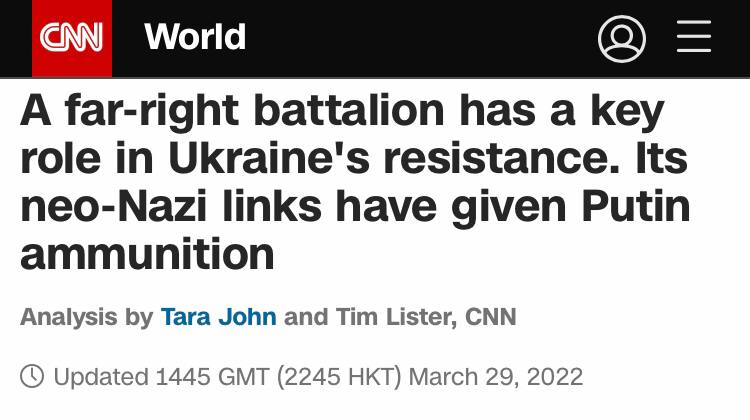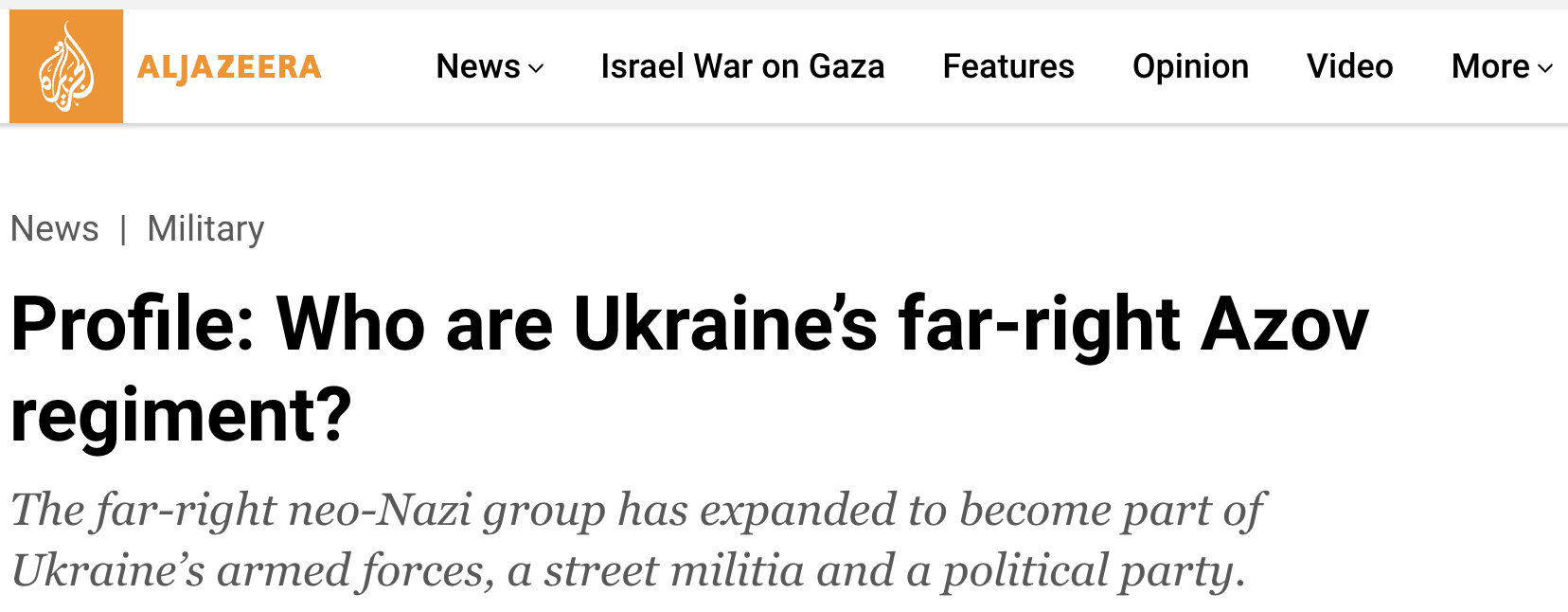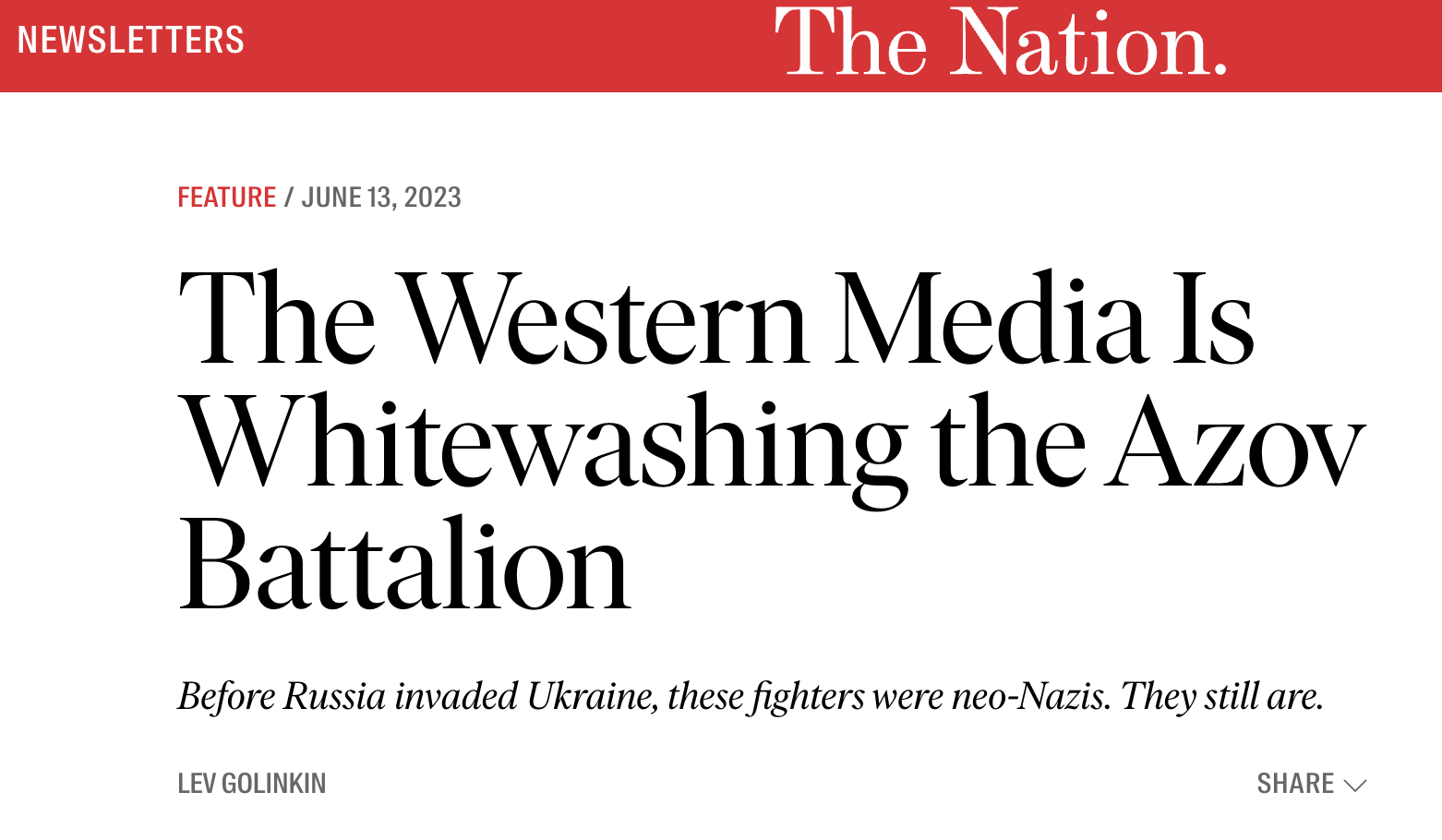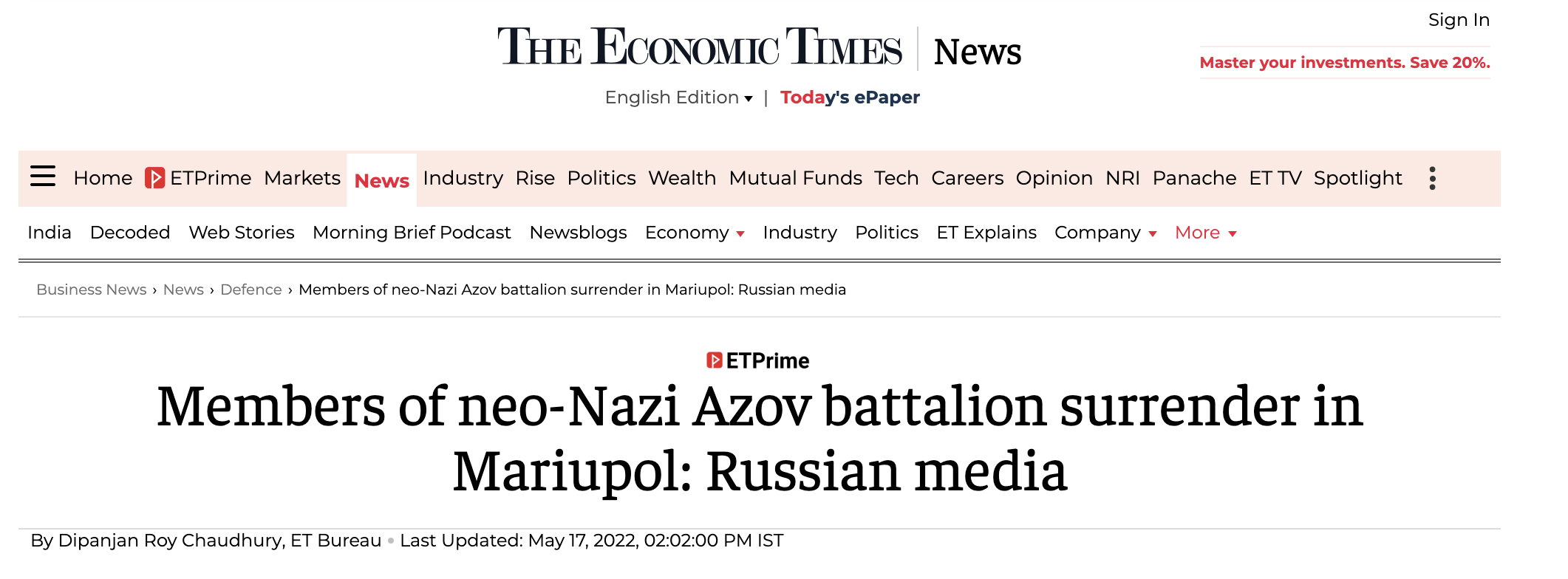Russian disinformation in Western media
Misunderstanding of Ukrainian history, the political situation, and cultural context, combined with a blind trust in Russian media narratives regarding the Ukrainian military unit, helped scale and internationalize Russian propaganda. Some media outlets, even after the full-scale aggression of the Russian Federation against Ukraine, continue to refer to the argument of Azov’s neo-Nazism, essentially justifying the statements of Russian politicians about the necessity of “denazification.” However, this serves another purpose – “moral procrastination” regarding assistance to Ukraine, as noted by Anton Shekhovtsov, Director of the Centre for Democratic Integrity. Russian propaganda creates psychological discomfort, trying to press on sensitive points of Western people, diverting their attention from truly important issues, such as hospital bombings, to the search for tattoos or politically incorrect statements by some ordinary servicemen.
“The actual reason for attempting to stop the Azov unit through hybrid methods is its combat effectiveness during the defense of the state against military aggression,” stated the Minister of Internal Affairs, Arsen Avakov.
The spread of disinformation in the media undoubtedly remains one of the essential tools of influence, but it is far from the only one. Marginal politicians and political movements, bribed experts, and human rights activists are traditional lobbyists for Kremlin interests abroad. In summary, the scheme is quite simple: to launch a “crusade against Nazism,” one must first invent it:
• Since 2014, they chose Azov and labeled the unit as “neo-Nazi”;
• From 2014 to 2022, they worked on creating an alternative reality with fakes about various crimes based on hatred attributed to the unit;
• In 2022, the Russians started a full-scale invasion under the pretext of the so-called “denazification”.
At the same time, some Western analysts write:
• “The West’s inability to properly understand the Azov movement has led to the spread of damaging anti-Ukraine propaganda in the media,” — Alexander Ritzmann, Counter Extremism Project.
• “…it’s clear that at some point, the regiment made a conscious decision to drop everything and just focus on being soldiers. At the moment, in fact, the regiment is mostly sitting in Russian captivity, having fought bravely in Mariupol in 2022. They don’t have time now for politics. As it stands, and as you can see from their online content, the Azov Regiment does not seem to be ideologically motivated,” — Kacper Rękawek, International Centre for Counter-Terrorism.
• “Azov and the National Corps are different structures with different plans. Although there are certain individual contacts, most of the Azov soldiers do not share the ideologies of far-right or neo-Nazis,” — Adrien Nonjon, Sorbonne-Université, Associate researcher at George Washington University.
• “The impact of Russian propaganda is quite significant. The case with the Azov regiment was used to portray Ukraine as a Nazi state, but among the Ukrainian defense forces, it remains in the minority. The influence of this structure is exaggerated,” — Louis Odette Gosselin, Scientific and Strategic Director of the Center for Preventing Radicalization Leading to Violence.
The situation in the information field was significantly worsened by the inclusion of “Azov” in Meta’s list of “dangerous organizations” in 2016. By 2019, Meta had banned any mentions, quotations, the name itself, and photos and videos with the symbols of the unit. All users associated with covering news about the unit were blocked. This deprived the representatives of the regiment of the opportunity to inform the world about the unit’s activities, and for platform users, it deprived them of the ability to obtain objective information beyond Russian sources. It effectively prevented public criticism or refutation of Russian disinformation on Facebook and Instagram.
January 2023
In January 2023, with the assistance of the Ministry of Digital Transformation of Ukraine and additional clarification of the situation for the tech giant, Meta excluded Azov from the list of “dangerous organizations,” restoring the ability to freely comment on and document the activities of the military unit. This clarified and distinguished Azov as a military unit and the mythical “Azov Movement” for Meta.
However, the majority of foreign publications discrediting the Ukrainian unit not only can be found online but continue to multiply. Let’s recall some of the most notable examples:
One such vivid example is the so-called “documentary chronicle” by Simon Shuster for Time, which garnered over 2 million views since its publication. From the first minutes, a familiar propaganda tale about the alleged involvement of a New Zealand terrorist and right-wing radicals from Charlottesville in the Azov unit is presented. Ultimately, a clear parallel is drawn between the ideology of White Supremacism worldwide and the unit itself. There is no confirmed example of former foreign fighters of Azov returning home after military service in the unit and engaging in the radicalization or perpetration of terrorist acts.
Researcher of far-right extremism Michael Colborne follows Russian narratives in his numerous publications about Azov: he claims that Azov was not depoliticized, confuses the activities of Andriy Biletsky’s political party with the Azov regiment, and suggests that war is most needed by Azov (and certainly not Putin?).
“Azov was founded on war, so it needs a war, whether a real or a metaphorical one. As I say in my book, war gives the far-right a raison d’etre and a goal. If they get another war in 2022, whatever they say, they will be happy about it.”
The headline “Azov needs a war” sets the tone for an interview with Michael Colborne just on the eve of the “great war.” From the title alone, we see a total shift of focus and support for conspiracy theories regarding the threat to democracy from Azov, while obvious threats from Russian bayonets are overlooked.
Just before the start of the full-scale invasion, Colborne’s multi-year investigation book titled “From the Fires of War: Ukraine’s Azov Movement and the Global Far Right” was published. This book largely presents a conspiracy theory about Ukraine’s political landscape. The book is permeated with anachronisms, portraying certain figures in Ukrainian history as “anti-Semites,” such as Kyivan Prince Sviatoslav, adding a strange description for anyone previously interested in the history of Kyivan Rus: “a barely remembered figure out of school history textbooks.” Moreover, it portrays them as non-independent historical subjects, labeling Hetman Pavlo Skoropadsky as “pro-German” and the national liberation movement, the Organization of Ukrainian Nationalists (OUN). This criticism and exposure of lack of independence and subjectivity are valid only from the perspective of Russian imperial chauvinism. With the same ease, one can read a regular commentary in Russian media about the “protection of Washington’s interests” in describing battles in some villages in the Kherson region.
“Despite unconvincing efforts to separate the two, it’s clear that the Azov Regiment is part of the broader Azov movement and should not be treated as something distinct from it. A military unit like the Azov Regiment has no place in a democratic country’s armed forces and should be disbanded.”
Therefore, the book, saturated with Russian propaganda stamps, was supposed to be printed just before the full-scale invasion, legitimizing Russian “denazification” and calling for the elimination of one of the most combat-effective military units in Ukraine.
Another well-known Western journalist adding confusion to the distinction between a military unit and the political initiatives of former servicemen is Christopher Miller. In his material for RFERL, he suggests that Azov is aimed at recruiting foreign volunteers to serve in the unit.
In the midst of the defense of Mariupol, Tara John and Tim Lister publish a piece on CNN mentioning Azov as a “far-right battalion” and noting that it has “military and political wings,” and their “separation occurred with the creation of the National Corps party in 2016.” At the same time, according to the authors, Azov joined the National Guard of Ukraine. The article, dated March 30, 2022, claims that “the battalion still operates as a relatively autonomous entity,” precisely when Azov is following direct orders from military command to defend the city and draw the enemy’s forces. Finally, the authors cast doubt on the advisability of providing Western assistance to Ukraine due to the existence of Azov within the Armed Forces of Ukraine.
When the defenders of Azovstal fall into captivity, Reuters publishes material repeating propagandist claims that the symbolism of Azov is the “wolfsangel” used by neo-Nazis, and the entire unit was formed based on one far-right organization.
In the summer of 2023, Lev Golinkin published sensational material in “The Nation,” accusing Western media of “whitewashing the Azov Battalion.” From the title, it is clear that this is about a Russian propagandist construct that has nothing to do with the military unit — again the “military wing,” again “neo-Nazism,” again “recruitment of extremists worldwide,” again the blame for a “deadly surge of white supremacy that stretches from New Zealand to Buffalo, N.Y.” Saturated with stamps reminiscent of Russia Today, the publication gained popularity — critical reviews and refutations were spread, including by Francis Fukuyama. The author of the “End of History” concept is hardly to be blamed for far-right views.
“I think you need to do a little more reading on Azov,” he wrote. “They originated among Ukrainian nationalists, but to call them neo-Nazis is to accept Russia’s framing of what they represent today. By the time they defended Mariupol they were fully integrated into the [Armed Forces of Ukraine] and are heroes that I’m proud to support,” wrote Francis Fukuyama.
This obsession with the Russian myth about the “Azov battalion” demonstrates a lack of engagement with Ukrainian sources. At the same time, the blindness of Western observers to the complete visibility of open Nazis, war criminals within Russian forces is surprising. One can recall Dmitry Utkin, the commander of the Wagner group, with Nazi tattoos (and a joint photo with Putin in the Kremlin), or Alexey Milchakov from the “Rusich” group, who has committed a series of hate crimes but still has no problems with Russian law.
Researcher Alasdair McCallum concludes that the lack of knowledge of the local context and the absence of work with Ukrainian sources allowed this myth to solidify in Western journalistic and academic circles.





